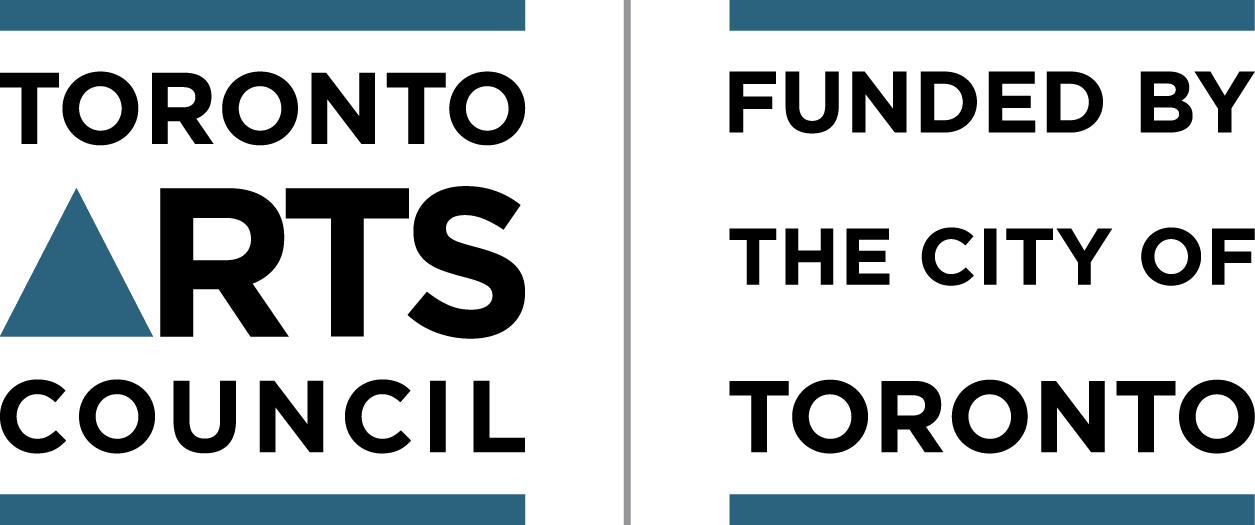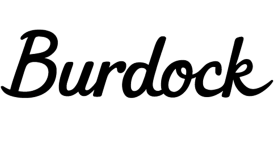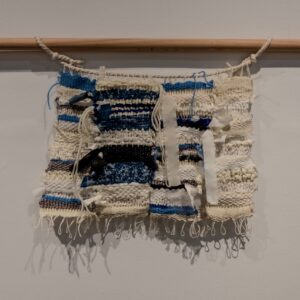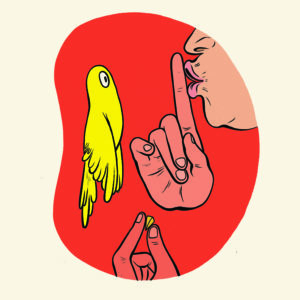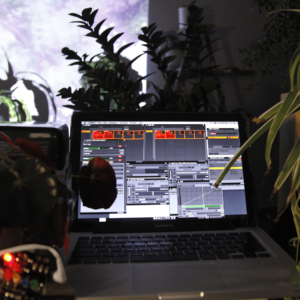ABOUT THE EXHIBITION
Lingering Echoes brings into conversation personal sound-centered artworks by artists Aliyah Aziz, Ghislan Sutherland-Timm, Middle, Tanya Workman, and Winta Hagos. Collectively and individually, the artworks take up themes of resistance, collectivity, embodiment, silence, and resilience. Lingering Echoes ask where the individual ends and the collective begins within the porosity of space and temporalities.
This exhibition is the result of “Sounding Spaces” course, part of the Train to Present program led by instructor/artist Nicole Marchesseau.
Curated by Nicole Marchesseau and Fatma Hendawy.
FEATURED ARTISTS
Aliyah Aziz
Aliyah Aziz is a multidisciplinary storyteller, poet and musician who uses light to talk about shadows, and sound to physically move them through us. She uses disruption as a tool of resistance, embracing glitch and static to channel the friction that exists between the surface and the depth of the technology that we engage with. Aliyah’s expressions take many forms, from multimedia moving collages of archived material, experimental sound and poetry compositions, interactive media installations, to performance art. She considers her practice to be an exploration of identity and the power that stories hold, from the history of our shadows to the projection of our futures.
Aliyah works with experimental sound techniques and audio archives such as voice loop samples on magnetic tape, as well as electromagnetic frequency statics made audible in combination with spoken word recitations. She is currently exploring live performance in 5.1 using different instruments she has built to direct the power of the “auditory glitch” as a liberating disruption in confronting naturalized instances of dehumanization of the “Other”. Aliyah finds that cultural resilience is only possible through resistance, and her work is how she does this, using sound as a material force.

Ghislan Sutherland-Timm
Ghislan Sutherland-Timm (they/she) is a multidisciplinary craftsman, media-based researcher, and cultural worker based in Tkaronto/Toronto. Their practice braids archival materials with collage-based techniques across a diverse range of mediums, including analog, to shape autobiographical-fictional narratives centred on ambiguous beings and land formations. Sutherland-Timm volunteers at the8fest Small Gauge Film Festival and The ArQuives. They hold a BFA in Integrated Media from OCAD University and are an alum of the Independent Imaging Retreat: Film Farm (2024) and Black Women Film! Canada (2019).
Previous works of Sutherland-Timm’s has been featured at Sankofa Square (Yonge & Dundas Square) (2025), Artist Project (2024), InterAccess (2024), Xpace Cultural Centre (2024), ArtSpace Gallery (2023), Images Festival (2023), PITCH Magazine Issue 4 (2023) & Issue 2 (2021), RBC Commission Career Launcher OCAD U x RBC (2022), InsideOut 2SLGBTQ+ Toronto Film Festival (2022), Toronto Queer Film Festival (TQFF) (2022), and Nia Centre for the Arts in collaboration with McMaster Museum of Art (2021).

Middle
Middle is a multidisciplinary musician, producer, and sound artist whose practice bridges identity, mental health, and social justice. As a queer, Black artist, she expands her musical world into the realm of installation, using sound as an aura, designed to surround, hold and tell stories.
Her sonic practice blends genres, while also exploring the use of optimal tunings, meditative frequencies, and resonant textures that move beyond entertainment into embodied listening. Through field recordings, synthesized instrumentation, and live soundscapes, she builds immersive sonic environments where audiences don’t just hear, but feel and inhabit sound as space.
Her music has been featured on Prime Video’s Dating Unlocked and TVO’s The Agenda with Steve Paikin, while her remix series #MiddleMix and original works have drawn recognition from artists such as Sampa the Great and Jessie Reyez.
Beyond her own artistry, Middle is an arts educator and mentor committed to fostering spaces where BIPOC and LGBTQ+ creatives can thrive. With over a decade in community-based work, she bridges creative expression and industry knowledge, equipping emerging artists with the tools to navigate their careers with intention. Her dedication was recognized with the 2024 Community Recognition Award from MPP Chris Glover as a Youth Leader.

Tanya Workman
Tanya Louise Workman is a multidisciplinary artist and writer who works with spoken word, text, images and vibration to create tactile installations that oscillate in the space between what is heard, seen and felt. Listening in to make audible what the body holds, she arrives at her practice through a trauma-informed lens, and is most interested in holding spaces that invite intimacy, connection and embodied, felt experiences.
Tanya received her MFA from Maine Media College + Workshops in 2022. She also holds a Bachelor of Journalism from Carleton University, a post-graduate certificate in creative writing from the Humber School for Writers and a photojournalism diploma from Loyalist College.
Her work has been exhibited and screened in spaces in Toronto and internationally, including at Gallery 44, MOCA Toronto, CONTACT Gallery and the Gladstone Hotel, and with PhotoSensitive, Project Re•Vision, Magnum in Motion and Workman Arts.
As a journalist, Tanya’s writing has appeared in the Toronto Star, The Globe and Mail, TV Guide Canada and Canadian Living. Her radio doc, “What Happened to Your Face?,” about the stories we tell about difference, aired on CBC Radio’s The Doc Project.

Winta Hagos
Winta Hagos is a Toronto-based multisensory artist and sound archivist whose work explores the intersection of sound, science, and cultural memory. Centering East African sonic traditions, she uses archival recordings, sculptural sound objects, and cymatics to investigate how sound can be both form and feeling. Her practice is rooted in community engagement, upcycling, and deep listening — creating immersive experiences that connect participants to epigenetic memory, emotional release, and spatial storytelling.

October 23 - November 30, 2025
OPENING RECEPTION
Thursday, October 23, 2025 | 5-6:30 PM
WA OFFSITE (32 Lisgar, 2nd Floor, Room 12)
No Reservations Required.
Thursdays – Sundays, 1-6 PM
Workman Arts OFFSITE
32 Lisgar St. 2nd floor, Room 12
ALSO OF INTEREST
Tending to What Remains
Curated by Manar Abo Touk
In times of rupture, care often begins with what the body remembers—scent, soil, texture, breath.
Tending to What Remains is a multidisciplinary group exhibition that reimagines the gallery as a living garden: a shared ecosystem of care. Set within Workman Art’s Being Scene 2025, it explores how artists with lived experiences of displacement, intergenerational grief, or mental health struggles turn to organic and everyday materials such as herbs, cotton, hair, wax, paper, and sound, to reflect on trauma, recovery, and community resilience.
Guided by diasporic, feminist, and ecological ways of knowing, Tending to What Remains gathers the work of Xece/Khadija Baker, Anna Williams, Shannon Taylor-Jones, Nadine Hajjaj, and Jawa El Khash. Together, their works create a contemplative space that explores themes of memory activism, collective tending, and the everyday rituals that sustain us.
Photography by Henry Chan.
ABOUT THE CURATOR
Manar Abo Touk
Manar Abo Touk (she/her) is a Syrian-born Canadian independent curator and PhD candidate in Art History at Concordia University in Tiohtià:ke/Montreal.
Her doctoral research explores contemporary Syrian art in the diaspora, with a focus on memory, displacement, and anti-violent image-making. With over a decade of experience in the international arts sector, she has curated more than thirty exhibitions and collaborated with artists across the SWANA region, Europe, and Turtle Island.
Her practice is grounded in cross-cultural storytelling and political aesthetics, and is shaped by methodologies of slowness and attentive listening. She has held positions as the Arts Manager and Curator at Al Riwaq Art Space in the Kingdom of Bahrain and Curator of Exhibitions and Collections at the Art Gallery of Grande Prairie, Treaty 8, Alberta.

FEATURED ARTISTS
Xece/Khadija Baker
Khadija Baker is a Montreal-based, multidisciplinary artist of Kurdish-Syrian descent. Baker immigrated to Canada from Syria in 2001; she completed her MFA studies at Concordia University in 2012. She is a core member of the Centre for Oral History & Digital Storytelling (COHDS) at Concordia University. Her installations investigate social and political themes centred on the uncertainty of home as it relates to persecution, identity, displacement, and memory. As a witness to traumatic events, unsettled feelings of home are a part of her experience. Her multidisciplinary installations often combine textiles, sculpture, performance, sound and video, and involve participative storytelling and performance to create active spaces for greater understanding. In 2023, Baker finished her HUMA PhD research-creation at the Centre for Interdisciplinary Studies in Society and Culture (CISSC) at Concordia University.
Baker has had solo exhibitions at galleries and institutions across Canada and has exhibited internationally at many cultural capitals. She was also awarded several research, concept-to-realization, and travel grants from the Canada Council for the Arts and the Conseil des arts et des letters du Québec. She was a winner of the 2020 Cultural Diversity in Visual Arts, and Rewilding Arts Prize awarded by David Suzuki Foundation and Rewilding Magazine. Most recently she was awarded the Miriam Aaron Roland Family Scholarship for her research creation at Concordia University.

Anna Williams
Anna Williams, Originally from Ottawa, ON., after studying sculpture and printmaking at Mount Allison University in New Brunswick, I returned home, where I continue to work and garden with my wife, children, dogs and an excessive number of house plants.
For the natural world and for myself, physical and psychological borders define our reality. The borders between feminine and unfeminine, human and animal, tameness and wildness, savage and civilized—rules about what is natural and what isn’t—have governed my life. I have struggled and failed to fit traditional definitions of femininity—too male to be female and too female to be male. In my practice, I engage with what is considered appropriate female behavior as I explore the physicality of making art, the construction and manipulation of female identity, and power relationships in contemporary society.
I feel a critical need for alternative definitions to be introduced to the binary expectations of womanhood, definitions into which I, a queer female artist and mother, might fit without having to sacrifice parts of myself deemed unacceptable and incongruous. As my domestic roles take over more of my identity, it is becoming increasingly impossible to integrate myself and my family into society’s assumed heteronormative definitions of those identities. Through an exploration of family history and myth via drawing, print, sculpture and installation, I consider what we have lost in our passage from nature to culture—our skewed experience of the natural world and female identity, and reflect on how this dissociation has impacted my mental health, identity and sense of belonging.

Jawa El Khash
Jawa El Khash is an artist, researcher and technologist. She artistically adopts the mediums of holography, web based simulation, 3D modelling, and virtual reality to archive, re-imagine and resurrect cultural artifacts, art history and botanical life. Her work is inspired by the celebration of intercivilizational exchange of ideas, craft, and cultural heritage, while looking into the future of museology, digital archaeology and 3D heritage. Her work has been part of several exhibitions, festivals, workshops, publications and artist talks nationally and internationally. She was long listed for the Sobey Art Award presented by the National Gallery of Canada (2021) and a finalist for the Art Jameel Prize presented by The Victoria & Albert Museum and Art Jameel (2024).

Shannon Taylor-Jones
Shannon Taylor-Jones is an interdisciplinary artist who works with fibre, painting, and the earth to explore the entangled biological and creative processes of life and death. Submerged into the underworld of plant and fungal embodiment, she looks to the more-than-human world in consideration of non-linear practices of growth, decay, and grief. Embodying the self as a symbiont, her work exists as an exploration of detritus in ecosystems of collaboration and interdependency.
Shannon has a BFA from OCAD University and is based in Toronto/Tkaronto.

Nadine Hajjaj
Nadine Hajjaj is a Palestinian artist working in printmaking, handmade paper, and book arts. Her practice examines how material can carry memory, political, cultural, and personal, across time and space. Treating paper as both object and site, she creates works that function as living archives, merging traditional craft with contemporary forms.
An aspiring publisher, Hajjaj is drawn to books as collaborative and participatory platforms for social and cultural commentary. Her interest lies in creating publications that expand beyond the page and objects that invite engagement, hold histories, and sustain dialogue.
Hajjaj’s work has been exhibited internationally, including at The Art Academy of Cincinnati (Ohio), Pique Gallery (Kentucky), The BasketShop Gallery (Cincinnati, Ohio), Gazala Projects (Gettysburg, Ohio), Open Studio (Toronto), and The Spilled Milk Gallery (Amman, Jordan).
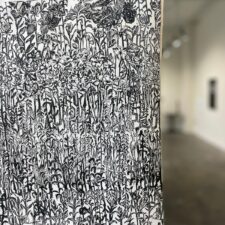
HISTORY OF BEING SCENE
Being Scene is an annual juried exhibition of recent artwork by Workman Arts members and individuals who have accessed the Centre for Addiction and Mental Health (CAMH) services in their lives.
Being Scene began over 20 years ago on the grounds of the Centre for Addiction and Mental Health (CAMH). Over the years, Being Scene has exhibited juried surveys of thousands of artworks by Workman Arts member artists as well as artists with lived experience who have received services from CAMH. Being Scene is an invaluable professionalization experience for artists, consistently reaching audiences of over 5,000, allowing for a greater understanding of diverse experiences. Artists have given shape to compelling ideas and narratives, covering a wide range of conceptual and material approaches. Being Scene has been shown in spaces such as The Gladstone Hotel, Toronto Media Arts Centre, various Artscape locations, and at CAMH.
For further information, interviews or images, please contact Tai Nguyen at tai_nguyen@workmanarts.com
To receive email updates about Being Scene’s annual exhibition launch sign up for the mailing list.
Natures Algorithm by Jawa El Khash.
GALLERY HOURS
- SEPTEMBER 4 - OCTOBER 5, 2025
- WEDNESDAY TO SUNDAY, 1-6 PM
- Workman Arts OFFSITE
- 32 Lisgar St, 2nd Floor, Rooms 8 & 12, Toronto
PUBLIC PROGRAM
We are the Earth with Bishara Elmi
- OCTOBER 4, 2025
- 1-4 PM
- Workman Arts OFFSITE
- 32 Lisgar St, 2nd Floor, Rooms 8 & 12, Toronto
ACCESSIBILITY
PURCHASE ARTWORK FROM BEING SCENE 2025
HOW WAS YOUR EXPERIENCE AT BEING SCENE 2025?
Special thanks to LIFT for supporting Being Scene.
Interested in sponsorship? Click here to download our sponsorship package or contact Tai Nguyen, Communications Manager, for more information.
The 2024/25 Artist in Residence Exhibition at Tangled Art + Disability is NOW CLOSED
The Artist in Residence program is part of Workman Arts’ Rendezvous with Madness Festival and is in collaboration with Tangled Art + Disability. Our 2024/25 Artist in Residence is Helen Kong.
This exhibition introduces Helen Kong’s interconnected practice; between object making, self awareness and close observations, Helen interweaves a wide range of concepts and materials into her artistic practice.
ReHoming emerges from a careful consideration towards objects and their meanings, blurring the differences between personal archives and historical objects is at the core of this exhibition. In ReHoming, we experience a full cycle of making the personal public and the public personal, while manifesting acts of care, togetherness and continuity.
This live exhibition aims at capturing Helen’s deep and tangled connections with personal objects, yet, it opens up endless possibilities to how and where objects can be taken care of.
While untangling such connections, Helen takes us through a close observation to the process of letting go and claiming, both objects and feelings.
ARTIST STATEMENT
“After a stressful residential move during the pandemic in 2021, where I lost my home of 10+ years and needed to rehome beloved pets, packed my life rapidly into storage, and found myself transitioning in between spaces that feel yet to be a home. ``ReHoming`` is a project that invites people to join in my journey of revisiting the past wounds, memories, and old dreams through sorting out my storage of belongings. I hold on to these items that seem dear to me, but can no longer keep them. As part of my practice of letting go of the material things along with the sentiments that no longer serve me, I will be finding new homes for objects so they can have a new life."
– Helen Kong, 2024/25 Artist in Residence with Workman Arts & Tangled Art + Disability
This two-part installation will be a live exhibition where the artist will update the contents weekly during the exhibition period.
Part One: Rehoming Objects of Significance – These objects will be catalogued with their stories and dreams of future homes. They are available for people to bring home and revive them again.
Part Two: Rehoming Journal – A visual arts journal where Helen will create small entries to process the emotions throughout this journey (from small paintings/drawings, to weaving samples, to vessels) to rehome and process their overwhelming feelings, as they go through this necessary process of letting go and finding homes for objects that are sentimental, yet currently lifeless.
All the items will be documented in an Instagram account where people can read and listen to stories, details, and/or the history of each piece. DM on the account for inquiries and to request adopting items.
ABOUT THE ARTIST
Helen Kong is a tea practitioner, ceramic artist specializing in making tea wares for Japanese and Chinese tea, and the owner and facilitator of Secret Teatime; a clay space hidden in Scarborough where people sip tea and play with clay. Aside from making, she is also a ceramics teacher and a facilitator/organizer of multi-sensory events focused on tea and food where she shares her knowledge about the Way of Tea, its philosophies and how it relates to her daily life. After more than a decade of being a primary caregiver and working as an entrepreneur artist, her studies in ritualized tea have been a source of grounding and coping. Especially in times of life and creative burnout, depression, anxiety, and her own chronic illness. Her studies in tea is also a connection with her East Asian animist roots that allows her to maintain a deep relationship to the materials, tools, and objects she collaborates with in her practice and daily life. Helen is slowly moving from the rollercoaster mindset between over-consumption and scarcity -which manifests in hoarding tendencies- to having true connective appreciation with the objects that she chooses to have in her life. This is a continuous work in progress.
Some of her recent projects include the “Ichigo-Ichie Tea Project” during Nuit Blanche Toronto 2022 which was documented in the C Magazine (Issue 156) article by Jasmine Gui “Different Things in Different Scenes: Encountering Ichi-go Ichi-e in Tea”, “Meeting for Teas” visual arts residency at the Banff Centre (2023), “The Looms We Resemble” group exhibition with Workman Arts (2024), and “In One Chawan: Seasonal Food Labs” co-facilitated with Anson Ng.
ABOUT THE PROGRAM
The Artist in Residence program is part of Workman Arts’ Rendezvous with Madness Festival and is in collaboration with Tangled Art + Disability. By providing time and resources, we believe this can support the development of a body of work to become exhibition ready for a solo show at the Tangled Art + Disability gallery vitrine space. We offer this opportunity to a Workman Arts member who has not or has minimally exhibited their artwork, and would benefit from a solo exhibition.
Helen Kong is our Artist in Residence for the 2024/25 year.
FEB 14 - APR 11, 2025
Location: Tangled Art + Disability (Vitrines)
401 Richmond St W Suite 124, Toronto ON M5V 3A8
Special thanks to our collaborators and funders on the Artist in Residence program.
Curatorial Tour with Fatma Hendawy

ABOUT FATMA HENDAWY
Saturday, November 30, 2024
Time: 2 – 4 PM (ET)
Youngplace Hallway Galleries (180 Shaw Street, Third Floor, Toronto)
No Registration Required
Storytelling Circle with Sarah Abusarar

Storyteller, Sarah Abusarar will be accenting the exhibit by weaving Palestinian stories of long ago. The Palestinian traditional stories were told by women in the villages. It is a tradition that was passed down from generation to generation. Often the women would tell these stories while engaging in other folk art such as embroidery and weaving. Sometimes they would tell traditional stories and other times the women would share stories from their own lives as they wove. Sarah comes from one such family. She will be sharing stories that would have been told around the fire in her village Dura by her grandmothers and that she continues to tell in diaspora in order to preserve this ancient tradition.
ABOUT SARAH ABUSARAR
Saturday, November 23, 2024
Time: 12 – 3 PM (ET)
WA OFFSITE Gallery, 180 Shaw St. Unit 302
Registration Required
Maximum Capacity: 14
MORE EVENTS
COME HAVE TEA with HELEN KONG

Tea is beyond a beverage. In a tea gathering we engage in a mindful and meditative journey of making, drinking, appreciating, and reflecting with tea.
In this tea gathering, Helen will demonstrate a Chinese tea ritual and serve teas to the participants and attendees. This will serve as context to her piece “Tea by the Apricot Tree” made during the “Way of Weaving” course facilitated by Jana Ghalayini. The tea mat, woven and created into a carry case for a traveling tea set expresses the significance of tea gatherings as a circle of learning and healing through engagement. More information about the piece can be found at the exhibition “The Looms We Resemble”.
ABOUT HELEN KONG
Helen Kong is a second generation Chinese Canadian living and working in Tkaronto (Toronto). She studied her first ritualized tea while living in Japan. Chado (the Way of Tea) is a meditative life journey through tea and hospitality. It is the gateway into art, culture, and philosophy. After returning to Canada, she studied ceramics as a way to better understand tea vessels. She established Secret Teatime, a clay studio where people play with clay and sip tea. She has expanded from making tea wares for Japanese teas to also studying and making wares for her own heritage of Chinese tea.
Saturday, December 7, 2024
Time: 1 – 3 PM (ET)
Open to all – no registration required
Location: Hallway Galleries, Youngplace, Third floor, 180 Shaw St.
Free Entry
Photo: The Looms We Resemble Opening Reception, Henry Chan.
The Looms We Resemble
“The Looms We Resemble” is a group exhibition showcasing textile-based works by 6 artists who bring topics of belonging, the body, healing and ancestry. This unique exhibition is a work in progress as the artists developed their artworks during a weaving class led by instructor Jana Ghalayini. How can collective production of artworks precede curatorial themes and concepts, while we follow the slowness of weaving?
Weaving ideas, actions, memories, and stories together is a practice of care that we all share in time and space. This exhibition includes works by Aga Forfa, Apanaki, Tara Hakim, Merle Harley, Saretta Khan and Helen Kong. Our public programming includes a Storytelling Circle led by Sarah Abusarar and Tea Gathering by Helen Kong.
ABOUT JANA GHALAYINI
Jana Ghalayini (b.1993, Jeddah) is an artist based between Tkaronto, Canada and Jeddah, Saudi Arabia. Ghalayini holds a BFA in Printmaking from OCAD University and is a self-taught weaver who draws inspiration from her Palestinian heritage. Between intuitive weaving, mixed-media work and printmaking, she is interested in repetition and mark-making as process-based forms that act as rituals leading up to the final form of an artwork. She consistently investigates and reflects on the connection between tangible materials and fragmentation while exploring layers in her work and mindfully uses her practice to keep a record of gestural marks documenting personal memory, experience and ideas that can evolve as time goes on.
Youngplace Hallway Galleries (180 Shaw Street, Third Floor, Toronto)
Curatorial Tour:
Saturday, November 30, 2 – 4 PM
Led by Fatma Hendawy
PUBLIC PROGRAMMING
NOV 23 | Storytelling Circle
Saturday, November 23, 2024 | 12-3 PM
WA Offsite Gallery – 180 Shaw St. Unit 302
Registration Required
Maximum Capacity: 14
Storyteller, Sarah Abusarar will be accenting the exhibit by weaving Palestinian stories of long ago. The Palestinian traditional stories were told by women in the villages. It is a tradition that was passed down from generation to generation. Often the women would tell these stories while engaging in other folk art such as embroidery and weaving.
DEC 7 | Tea Gathering
Saturday, December 7, 2024 | 1-3 PM
Hallway Galleries, Youngplace, Third floor, 180 Shaw St.
Free Entry
In this tea gathering, Helen will demonstrate a Chinese tea ritual and serve teas to the participants and attendees. This will serve as context to her piece “Tea by the Apricot Tree” made during the “Way of Weaving” course facilitated by Jana Ghalayini.
ABOUT THE ARTISTS
Agnieszka (Aga) Forfa
Apanaki Temitayo
Apanaki Temitayo is a Toronto-based, disabled, mixed-media textile artist, art facilitator, and mental health advocate. Her work combines African fabrics and storytelling, often exploring themes of identity, heritage, and resilience. She has exhibited in various galleries and her workshops focus on the therapeutic aspects of art, aiming to foster mental wellness and community connection.
apanaki-temitayo-m.pixels.com
Arokin Iwure, Yoruba for Griot’s Prayer, 2024
Tara Hakim
Originally Palestinian, born and raised in Jordan with an Austrian grandmother, Tara Hakim creates public displays of vulnerability that invite the viewer to meditate on notions of self, diasporic existences, and spaces in between – both physically and mentally. Her first short film ‘Teta, Opi & Me’ screened in festivals around the world including RIDM, and won Best Documentary and Audience Choice at MOMO in Zurich 2019. Since then, Tara has been creating short films, experimenting with gallery spaces and currently exploring tactile mediums including ceramics, Tatreez, weaving and glass work.
but you are still here, 2024
Merle Harley
Merle Harley is an artist and maker who continuously creates visual alternate realities balancing the line between beautiful and uncanny. With no specific fixed media they work eclectically with what is readily available or collected. Using mediums such as drawing, painting, knitting, weaving, comic books, videos, built structures, as well as working in theatre and TV. They have exhibited work across Canada and beyond, in galleries and outdoors in site-specific locations and are particularly interested in stories based in nature, animals, mental health and queer themes.
warm hands weave shadows, 2024
Saretta Khan
Saretta Khan is Bangladeshi-Canadian born and raised in Toronto. Ever since being a child she has always been doing some form of art such as drawing and painting. She’s heavily influenced by her mother who is also an artist/painter. Her mother recognized Saretta’s talents at an early age and allowed her to explore and discover her passion for art. Currently, Saretta is a multidisciplinary graphic designer/artist who graduated from an advanced graphic design program at George Brown. She is also teaching art for The GEM (Giving Education Meaning)community program which allows her to introduce the wonders of art to students with learning disabilities. Her goal is to facilitate an inclusive space for them to express their creativity.
The Ocean, Textile, 2024
Helen Kong
Helen Kong is a second generation Chinese Canadian living and working in Tkaronto (Toronto). She studied her first ritualized tea while living in Japan. Chado (the Way of Tea) is a meditative life journey through tea and hospitality. It is the gateway into art, culture, and philosophy. After returning to Canada, she studied ceramics as a way to better understand tea vessels. She established Secret Teatime, a clay studio where people play with clay and sip tea. She has expanded from making tea wares for Japanese teas to also studying and making wares for her own heritage of Chinese tea.
Tea by the Apricot Tree, 2024
Illustration: Jenny Chen
IN THE EXHIBITION:
In Praise of Voice Notes and Penguin Pebbling (part of Mourning Microcosmmutes)
m. patchwork monoceros
ARTIST TALK
ABOUT THE EXHIBITION
Indebted to the words and thinking of disability justice educator Mia Mingus, wherever you are is where i want to be offers access intimacy as the un-structuring logic for our collective queer and trans crip futures. Refusing the loudly eugenicist mapping of isolation and disposability upon our disabled queer-trans-crip bodyminds, the multi-disciplinary practices platformed here speak with a loved urgency to the ways in which embodied experiences of access intimacy have the capacity to reconfigure time, space, and relation. Spanning installation to textile to video, the work of these artists proposes the act, experience, and feeling of crip kinship as a means and model of radical future-making.
ABOUT THE CURATOR
Sarah–Tai Black (they/them) is an arts curator and critic born and (mostly) raised in Treaty 13 Territory/Toronto whose work aims to center Black, queer, trans, and crip futurities and freedom work. Their curatorial work has been staged at Cambridge Art Galleries (Cambridge, ON), Dunlop Art Gallery (Regina, SK), MOCA (Toronto ON), PAVED Arts (Saskatoon, SK), and A Space Gallery (Toronto, ON).
ALSO OF INTEREST

AN IN-PERSON EXHIBITION
Kindness is not an act of weakness. It is an act that resists societal expectations of doing and saying nothing. This form of rebellion is evident in this year’s Rendezvous With Madness visual art exhibition whereby the six exhibiting artists address within their work personal experiences that challenge what mental health and wellness looks like. Action is apparent through frameworks of compassion, thought-provoking imagery and considerate storytelling.
IN THE EXHIBITION:
This year, the exhibition in the Rendezvous With Madness Festival will be presented in-person throughout the festival from October 27 to November 6.
VENUE
Workman Arts Offsite Gallery, Artscape Youngplace, 180 Shaw Street, Unit 302, Toronto
GALLERY HOURS
October 27 to November 6, 12 – 6 PM
EXHIBITION OPENING & ARTISTS TALK
October 29, 1-4 PM, Talk at 2:30 PM
After the opening reception, engage with the artists of kind renderings as they delve into their work and practice.
TOURS
Please join us for a guided tour on Thursday, November 3 at 5 PM
ACCESSIBILITY
If in-person access is a barrier, please contact Raine Laurent-Eugene at raine_laurenteugene@workmanarts.com
Visit the Accessibility page for further festival information and wayfinding.
WORKMAN ARTS MEMBER ARTISTS JURY:
Sylvia Frey, Visual Artist, Toronto
Sylvia Frey is a Mad, Queer, BIPOC Visual Artist based in Toronto. Her artwork explores the intersection of Madness, Healing, and Art. She is an interdisciplinary artist, working in the mediums of painting, drawing, writing, and performance. Most currently, she has started to explore film and photography. Her artwork can be found in various private collections in North America and Europe.
Esmond Lee, Visual Artist, Researcher, and Architect, Toronto
Esmond Lee is an artist, researcher, and architect based in Scarborough. Lee explores long-term, intergenerational experiences of migration in peripheral spaces. He holds a Master of Architecture and is pursuing a Doctorate in Critical Human Geography. Lee draws from these seemingly diverging backgrounds to examine identity, belonging, and nuanced cultural and political borders in the built environment. Recent works include installations for Nuit Blanche Toronto, developed during his time as the Doris McCarthy Artist-in-Residence, and at Malvern Town Centre for CONTACT Photography Festival. Lee’s current projects include two photobooks: ‘Below the City’, recognized by the Burtynsky Grant, and one for Woodside Square Library as the TPL Artist-in-Residence.
Laura Shintani, Visual Artist, Toronto
Laura Shintani is a multimedia multidisciplinary artist who’s curiosity leans into learning, leadership and making friends with the interior monologue of the mind. Having a Japanese-Canadian ancestry, she directs themselves to create work that re-connects a disconnected past to the present. She lives with and embraces neurodiversity.
Her work has been shown at the Royal Ontario Museum, Campbell House Museum, Tangled Arts + Disability and Workman Arts. She helps to facilitate CAMH’s client “Art Cart” through Workman Arts and has received grants from and has been on juries for the Ontario Arts Council. Her most recent skill is trying her hand at taiko drumming!

A Virtual Exhibition
In-Site, Incite, & Insight
Rather than experience the festival’s exhibition on-site, this year we experience it “in-site” — in a website, in the digital world, in the virtual. The works in the festival this year have been selected with the intention of being experienced virtually.
The artists bring insight to their experiences of the world having changed, how it continues to change and what this change can offer. This includes our growing awareness around mental health, our relationships with both the physical and digital worlds, and how the works can incite us into action. The exhibiting works investigate these themes and more, providing room to engage with the arts in a time when interacting and experiencing work has been significantly impacted. Through these works, we recognize that we are in the moment, in the current, in the site.
Visit the virtual exhibition here:
insite.workmanarts.com
IN THE EXHIBITION:
This year, the exhibition in the Rendezvous With Madness Festival will be presented virtually which will be accessible throughout the festival from October 28 to November 7. Work including timed events and performances will be accessible through the virtual exhibition site through the link below:
VIRTUAL GUIDED TOUR
Watch the virtual guided tour of the In(site) exhibition held on Sat, Oct 30, 12 PM ET
SPECIAL IN PERSON FEATURES
- How we cared video installation will be on the ground floor window of 1025 Queen St W, available 24/7.
- UNBREAKABLE performance will be presented live on opening night, in the CAMH Auditorium at 1025 Queen St W.
ONLINE LIVE EVENTS
- Green Gazing invites the public to engage in a movement class as a virtual participatory performance on the final day of the festival.
ARTIST TALKS
- Szepty/Whispers:Dialogue
Collaborator Artist Talk - Self Isolation – Learning to make Computational Art during a Global Pandemic
A Master Class by Chelsea Watson
ACCESSIBILITY
If either online or in-person access is a barrier, please contact Paulina Wiszowata at paulina_wiszowata@workmanarts.com.
Workman Arts will have available the In(site) virtual exhibition displayed and interactable on a monitor in their front office at 1025 Queen St W Suite 2400.
Available during Box Office hours:
Monday – Friday, 10 AM – 4 PM.
Visit the Accessibility page for further festival info.











